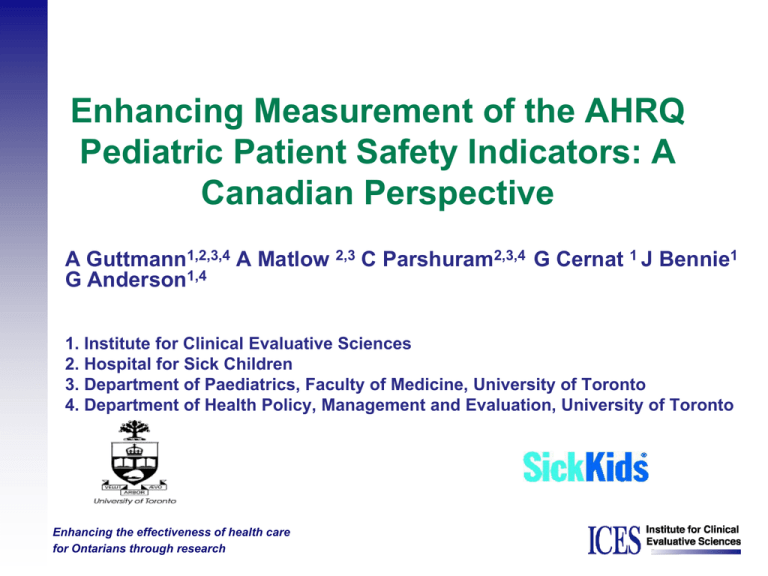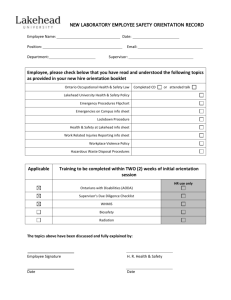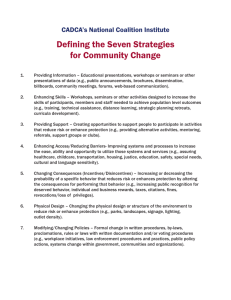Enhancing Measurement of the AHRQ Pediatric Patient Safety Indicators: A Canadian Perspective
advertisement

Enhancing Measurement of the AHRQ Pediatric Patient Safety Indicators: A Canadian Perspective A Guttmann1,2,3,4 A Matlow 2,3 C Parshuram2,3,4 G Cernat 1 J Bennie1 G Anderson1,4 1. Institute for Clinical Evaluative Sciences 2. Hospital for Sick Children 3. Department of Paediatrics, Faculty of Medicine, University of Toronto 4. Department of Health Policy, Management and Evaluation, University of Toronto Enhancing the effectiveness of health care for Ontarians through research Disclosures • Funded by Canadian Institute for Health Research Ontario Ministry of Health and Longterm Care Enhancing the effectiveness of health care for Ontarians through research Clostridium difficile (C. difficile) Sept 30, 2008 Methicillin-resistant Staphylococcus aureus Dec 31, 2008 Vancomycin-resistant Enterococci (VRE) Dec 31, 2008 Hospital Standardized Mortality Ratio (HSMR) Dec 31, 2008 Rates of ventilator-associated pneumonia April 30, 2009 Rates of central line infections April 30, 2009 Rates of Surgical site infections –Hips and Knees April 30, 2009 Hand hygiene compliance among health care workers April 30, 2009 Monitoring of Safety in Hospitalized Children • Far fewer studies than in adults • No suggestion thus far that adverse • events are any less common than in adults Most studies have focused on care in children’s hospitals Care for sicker and more complex patients but not the majority of children needing acute care Enhancing the effectiveness of health care for Ontarians through research • Pediatric Safety Measures Using Administrative Data Developed by AHRQ Pediatric expert panel and data analysis to refine adult measures for children • McDonald et al. Pediatrics 2008 (122)e416-425 • Based on inpatient, single admission • data Predominantly used to assess care in children’s hospitals Enhancing the effectiveness of health care for Ontarians through research Measures • • • • • • Accidental puncture/laceration FB left in Post-op hemorrhage Post-op resp failure Post-op sepsis Post-op wound dehiscence Enhancing the effectiveness of health care for Ontarians through research • • • • Iatrogenic pneumothorax (neonates and nonneonates) Infection due to medical care Decubitus ulcer Transfusion reaction AHRQ PDIs • Validation that admissions with these • adverse events are longer and more costly • Kronman et al Pediatrics 2008(121):e1653-1659 Serious concerns about the data quality (present on admission) as well as preventability • Scanlon et al Pediatrics 2008 (121):e1731-1731 Enhancing the effectiveness of health care for Ontarians through research Goals of our Study • Refine these measures for use in Canada Adaptation to ICD-10 and increase case ascertainment through data linkage Explore the appropriateness of these measures for other acute care populations • Same day surgery • Use linked administrative data to calculate the refined measures across all hospitals in Ontario, Canada ( 12 million, 40% of Canadian population) Enhancing the effectiveness of health care for Ontarians through research Expert Panel • National experts in pediatric patient • • • safety (NICU, pediatric neurosurgery, infection control) Pediatric and community-based surgeons Pediatric hospitalist and ICU physician Community-based pediatricians Enhancing the effectiveness of health care for Ontarians through research • Process Rate each indicator on the basis of Common Significant morbidity to patients Preventable Drive QI Useful for accountability purpose Relevance for other populations • Discussion of refinements to indicators Enhancing the effectiveness of health care for Ontarians through research Results • 4 indicators dropped Transfusion reaction Post-op resp failure Post-op wound dehiscence Accidental puncture • 1 added Post-op pneumonia Enhancing the effectiveness of health care for Ontarians through research Figure 1. Proportion of Surgical Cases by Venue and Hospital Type, 2003 - 2007 Inpatient-Academic Children's N=42,677 (11% ) Inpatient-Other academic N=8,134 (2% ) Inpatient-Community N=43,038 (11% ) SDS-Community N=207,091 (56% ) SDS-Academic Children's N=63,753 (17% ) SDS-Other academic N=12,312 (3% ) Inpatient Same Day Surgery Comparison of Cases Detected Using Enhanced Definitions (2003-7) Measure Cases AHRQ Inpatient # of Cases hospitals Linkage Inpatient # of Cases hospitals SDS # of hospitals Decub ulcer 59 9 152 31 28 14 Foreign body 9 5 13 7 5 4 Post-op sepsis 202 20 281 27 40 17 Post-op hemorrh 131 27 170 36 401 63 Post-op pneum 160 24 285 45 170 48 Comparative Rates for Patient Safety Indicators - US 2003 vs Ontario 2003-2006 Rate per 1000 patients eligible for each indicator 25 US 2003 Rate 20 Ontario- AHRQ 2003-2007 15 10 5 0 Decubitus ulcer Infections due to medical care Iatrogenic pneumothorax Postoperative Hemorrhage or hematoma Postoperative sepsis* Patient Safety Indicator Conclusions • Data systems that allow linkage across hospital episodes increases the # of cases detected and # of hospitals included Applicable to other indicators – SSI’s • Most children who have surgery do so in same day setting Lower risk but huge volume Adverse events occur • Post hemorrhage most common in this group (tonsillectomies) Potential to bring community hospitals under the performance measurement umbrella Enhancing the effectiveness of health care for Ontarians through research Conclusions (cont’d) • Important issues still to be resolved around data quality Infections due to medical care (line infections) • Important adverse event, admin data not good enough • Some events are exceedingly rare (FB, pneumothoraces) Challenges in use for routine monitoring +/reporting • Currently no way to make hospital/peer group comparisons because no risk adjustment software for ICD10 Enhancing the effectiveness of health care for Ontarians through research


